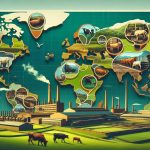Looking for more sustainable options for your wardrobe?
Check out these five eco-friendly alternatives to traditional fabric.
From organic cotton to pineapple leather, there are plenty of choices that are both stylish and environmentally conscious.
Say goodbye to harmful chemicals and hello to materials that are kinder to the planet.
Whether you’re a fashion enthusiast or just looking to make a positive impact, these alternatives are worth considering.
Table of Contents
Organic Cotton
If you’re looking for a more sustainable option for fabric, consider using organic cotton. Organic cotton is grown using sustainable farming practices that prioritize the health of the environment and the well-being of the farmers. Unlike conventional cotton, which is heavily reliant on synthetic fertilizers and pesticides, organic cotton is cultivated using natural methods.
One of the key aspects of sustainable farming practices in organic cotton production is the avoidance of synthetic chemicals. Instead, farmers rely on natural alternatives like compost and beneficial insects to control pests and maintain soil fertility. This reduces the negative impact on ecosystems and promotes a healthier environment for both humans and wildlife.
Additionally, organic cotton farming practices emphasize water conservation. Through efficient irrigation methods and the use of rainwater harvesting techniques, organic cotton farmers minimize water usage, which is particularly important in regions where water scarcity is a concern.
Hemp Fabric
When it comes to eco-friendly alternatives to traditional fabric, hemp fabric is a standout option.
Not only is hemp fabric highly breathable and durable, but it’s also produced using sustainable farming practices.
This means that choosing hemp fabric not only benefits the environment but also ensures that your clothing is long-lasting and comfortable.
Breathability and Durability
Hemp fabric offers excellent breathability and durability.
When it comes to breathability, hemp fabric allows air to flow freely through its fibers, making it a great choice for hot and humid climates. This breathability benefit helps to keep you cool and comfortable, as it allows moisture to evaporate quickly from the fabric.
In addition to its breathability, hemp fabric is also known for its durability. It’s a strong and sturdy material that can withstand regular wear and tear. This makes it ideal for creating long-lasting textiles that can withstand the test of time.
Sustainable Farming Practices
To ensure the eco-friendliness of hemp fabric, sustainable farming practices are employed in its cultivation. By utilizing sustainable agriculture techniques, hemp farmers minimize their environmental impact and promote long-term soil health.
Here are three ways in which sustainable farming practices benefit hemp fabric production:
-
Regenerative farming: Hemp cultivation focuses on regenerating soil health by minimizing soil erosion and nutrient depletion. By rotating hemp crops with other plants, farmers enhance soil fertility and reduce the need for synthetic fertilizers.
-
Natural pest control: Sustainable hemp farming relies on natural methods to control pests and diseases, such as companion planting and beneficial insects. This eliminates the need for harmful chemical pesticides, making hemp fabric a safer and healthier choice.
-
Water conservation: Sustainable hemp farming practices prioritize water conservation through efficient irrigation techniques and rainwater collection. This helps preserve water resources and reduces the strain on local ecosystems.
Bamboo Fiber
Looking to reduce your environmental impact? Interested in sustainable fabrics? Curious about bamboo fiber? Bamboo fiber is a great alternative to traditional fabric, as it offers a range of benefits for both you and the environment.
Bamboo fabric is known for being breathable, making it an excellent choice for eco-friendly clothing. It allows air to flow through the fabric, keeping you cool and comfortable. Additionally, bamboo is a fast-growing and renewable resource, making it a more sustainable option compared to conventional fabrics.
Here is a comparison table that highlights the advantages of bamboo fiber:
| Property | Bamboo Fiber |
|---|---|
| Breathability | Excellent |
| Sustainability | High |
| Softness | Luxurious |
As you can see, bamboo fiber excels in terms of breathability and sustainability. Its softness is also a bonus, providing you with comfortable and luxurious eco-friendly clothing options. By choosing bamboo fiber, you can reduce your environmental impact while still enjoying high-quality and comfortable clothing. Give it a try and make a positive contribution to the planet!
Recycled Polyester
Looking for a sustainable fashion choice? Recycled polyester might just be the answer.
By choosing this fabric, you can contribute to the benefits of recycling and reduce your environmental impact.
It’s a win-win for both style and the planet.
Benefits of Recycling
Recycled polyester offers numerous benefits for those seeking sustainable fabric options. By choosing recycled polyester, you’re actively participating in reducing waste and supporting conservation efforts. Here are three reasons why recycling polyester is beneficial:
-
Environmental Impact: Recycling polyester reduces the need for new raw materials, such as crude oil, which helps conserve natural resources and decreases carbon emissions. This process also prevents polyester fabrics from ending up in landfills, where they can take hundreds of years to decompose.
-
Energy Efficiency: Recycling polyester requires less energy compared to producing virgin polyester. This reduction in energy consumption helps lower greenhouse gas emissions, contributing to a healthier planet.
-
Water Conservation: The production of recycled polyester consumes significantly less water than traditional polyester manufacturing. By choosing recycled polyester, you’re helping to conserve this precious resource.
Sustainable Fashion Choice
When considering sustainable fashion choices, opting for recycled polyester is a smart decision due to its numerous environmental benefits. Recycled polyester is made from post-consumer plastic bottles and other plastic waste, reducing the demand for new petroleum-based materials. This process helps divert waste from landfills and reduces the carbon footprint associated with traditional polyester production.
In addition to its eco-friendly properties, recycled polyester also promotes ethical manufacturing practices. Brands that use recycled polyester often support fair trade and ensure safe working conditions for their employees. By choosing recycled polyester, you’re supporting the slow fashion movement, which emphasizes quality over quantity and aims to reduce waste in the fashion industry.
Reducing Environmental Impact
Did you know that opting for recycled polyester can significantly reduce the environmental impact of traditional fabric production? By choosing recycled polyester, you’re making an ethical manufacturing choice that aligns with the values of eco-conscious consumers.
Here are three reasons why recycled polyester is a great option:
-
Reduced Energy Consumption: Producing recycled polyester requires less energy compared to virgin polyester. This means fewer greenhouse gas emissions and a smaller carbon footprint.
-
Less Water Usage: The production of recycled polyester consumes less water compared to traditional fabric production. By choosing recycled polyester, you’re conserving this precious resource.
-
Diverting Waste from Landfills: Recycled polyester is made from post-consumer plastic bottles and other discarded polyester materials. By using these materials, you’re helping to reduce waste and minimize the strain on landfills.
Tencel Lyocell
One of the eco-friendly alternatives to traditional fabric is Tencel Lyocell, which offers a sustainable option for conscious consumers. Tencel Lyocell is a type of fabric made from the wood pulp of trees, primarily eucalyptus trees. It is known for its breathability and durability, making it a popular choice for clothing and home textiles.
Tencel Lyocell is highly breathable, allowing air to flow through the fabric and keeping you cool and comfortable, especially in hot and humid climates. This makes it an excellent choice for summer clothing, activewear, and bedding. Additionally, Tencel Lyocell is known for its durability. It is resistant to wrinkles, shrinkage, and pilling, making it a long-lasting option for your wardrobe.
Here is a comparison table highlighting the key characteristics of Tencel Lyocell:
| Tencel Lyocell | |
|---|---|
| Breathability | Highly breathable, allows air to flow through |
| Durability | Resistant to wrinkles, shrinkage, and pilling |
| Sustainability | Made from renewable wood pulp, using a closed-loop production process |
Piñatex (Pineapple Leather)
To explore another eco-friendly alternative to traditional fabric, let’s delve into the world of Piñatex (Pineapple Leather). Here are three reasons why Piñatex is gaining popularity as a sustainable fabric option:
-
Sustainable Production Process: Piñatex is made from the leaves of pineapple plants, which are typically discarded after the fruit is harvested. By utilizing these waste materials, Piñatex helps to reduce agricultural waste and promote a circular economy.
-
Environmental Benefits: Compared to traditional leather production, Piñatex has a significantly lower environmental impact. It requires less water, land, and energy to produce, making it a more sustainable choice. Additionally, the production of Piñatex doesn’t involve the use of harmful chemicals or pollutants.
-
Versatility and Durability: Piñatex is a versatile material that can be used in a variety of applications, including fashion, accessories, and upholstery. It has a similar appearance and texture to animal leather but is lighter and more breathable. Piñatex is also known for its durability, making it a long-lasting and sustainable alternative to traditional leather.
The production process of Piñatex involves extracting fibers from pineapple leaves, which are then processed into a non-woven textile. This textile is then treated to enhance its strength and flexibility, creating a durable and sustainable fabric.
Frequently Asked Questions
How Is Organic Cotton Different From Regular Cotton?
Organic cotton differs from regular cotton in that it is grown without the use of harmful pesticides and chemicals. This benefits you by reducing exposure to toxins and benefits the environment by minimizing pollution.
Is Hemp Fabric as Durable as Traditional Fabrics?
Hemp fabric is as durable as traditional fabrics. It is a sustainable option due to its low environmental impact. Consider hemp fabric for eco-friendly alternatives to traditional fabric.
Can Bamboo Fiber Be Used for All Types of Clothing?
Yes, bamboo fiber can be used for all types of clothing. Its versatility and properties make it suitable for various applications. Bamboo fabric is breathable, absorbent, and hypoallergenic, making it a great eco-friendly alternative.
How Is Recycled Polyester Made?
Recycled polyester is made by collecting discarded plastic bottles, melting them down, and spinning the molten material into fibers. Using recycled polyester in clothing reduces waste and conserves resources, making it an eco-friendly choice.
What Are the Advantages of Using Piñatex (Pineapple Leather) Over Traditional Leather?
Using Piñatex (pineapple leather) instead of traditional leather has advantages. It is more sustainable, as it is made from pineapple leaf fibers, reducing waste. Additionally, it does not involve animal cruelty.
- Tetron Fabric for Marine Applications: Durability and Use Cases - June 18, 2025
- Tetron Fabric for Outdoor Furniture: Weather Resistance and Care - June 18, 2025
- Tetron Fabric for Wall Coverings: Style and Application Tips - June 18, 2025





